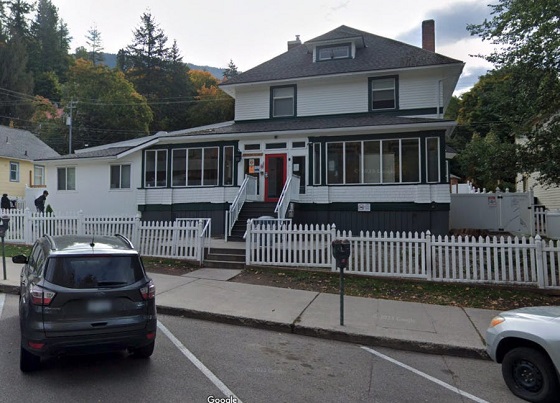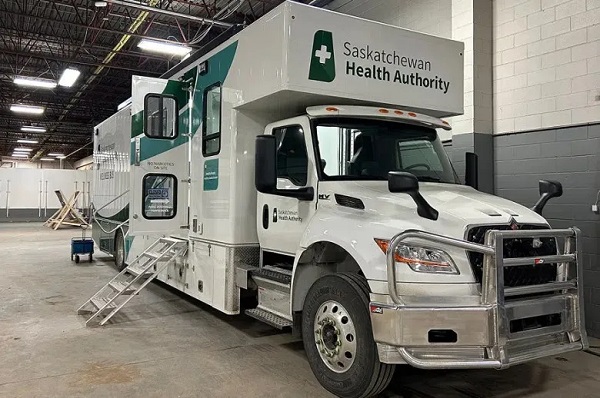Addictions
Harm reduction projects in Nelson are fraying the city’s social fabric, residents say

News release from Break The Needle
Public disorder and open drug use raise concerns in picturesque mountain-rimmed town.
“Just the other night, we had an intruder in our yard,” Kirsten Stolee recounted, her voice unsteady. Her two daughters often watch television with their windows open. “He easily could have gotten inside,” she said.
Stolee lives in Nelson, a picturesque, mountain-rimmed town in BC’s Southern Interior that is struggling with rising public disorder. Some residents, herself included, say that local harm reduction initiatives – which appear to be operating without adequate accountability and safety measures – are responsible for the decay.
Near Stolee’s house, one can find the Stepping Stones emergency shelter alongside the former Nelson Friendship Outreach Clubhouse, which used to provide support services for individuals struggling with mental health issues before being abandoned late last year.
When the clubhouse still operated, supporters claimed that it provided clients with a space to socialize and partake in “art, gardening, cooking and summer camp” – but critics countered that it was a drop-in centre for drug users. After the provincial government announced plans to open a supervised inhalation site at the clubhouse early last year, local residents protested and had the project, and eventually the clubhouse itself, shut down.
Although Stolee supports harm reduction in principle, she opposed the opening of the inhalation site on safety grounds. The incidents near her home were concerning: an assault just outside her window, a drug-addled individual stabbing a pole with scissors, people carrying weapons on the street in front of the site. When her daughter’s phone was stolen, it was eventually recovered from a man at the clubhouse.
Although the clubhouse is closed, Stepping Stones continues to operate and has been similarly chaotic. Stolee watched a suspected drug dealer attack one of the residents there, and learned that another resident had made an inappropriate comment to her daughter.
She has also observed fire hazards near local homeless encampments, including a burning electrical panel and abandoned fires, and says that local drug users “play with fires” on sidewalks and streets. She finds these incidents concerning, as BC and Alberta have recently been ravaged by large wildfires and Nelson’s downtown is filled with historic wooden architecture.
Calling the police seemed unhelpful. In one case, officers dismissed her concerns about a man who was carrying large rocks, considering him non-threatening. However, the man was later arrested for assault and for using these types of rocks to break into a gas station.
Gavin Halford, a representative of Interior Health, the provincial agency which oversees most of the region’s harm reduction programs, stated that his organization “does not tolerate or condone any form of criminal activity, including trespassing.” He claimed that Interior Health has taken “a number of steps to increase security at the Clubhouse,” including increased signage, lighting, video surveillance and on-site security services.
However, the acquisition of 24/7 security services was facilitated by Stolee’s partner, after Interior Health told him that no such options were available. The partner also alleges that he was told by local police officers that Interior Health asked them not to enforce the “No Trespassing” signs around the clubhouse.
Stolee’s family has since invested $1,000 into security upgrades such as video surveillance and fencing. “We have baseball bats and pepper spray by our front door and a bat under the bed,” she said, noting that she wrote a letter to BC Premier David Eby detailing their experiences, which received no reply.
Kari Kroker, another neighbour of Stepping Stones, said that downtown Nelson has experienced a noticeable decline as open drug use and trafficking have proliferated, including sales to youth. “The alley behind my house has become a place of screaming and chaos,” she said, expressing frustration at how some drug users have told local children that using drugs is a form of “play.”
“I’m all in favour of putting more money into this situation, but I think we’re going the cheap way,” said Kroker. “I don’t see the province doing much to solve this. I don’t see rehab and supports for people. We need rehab. Where are the facilities to support people?” She believes that the town’s social fabric is fraying and that “harmony has been completely undermined.”
Subscribe for free to get BTN’s latest news and analysis – or donate to our investigative journalism fund.
Tanya Finley, owner of Finley’s Bar and Grill and Sage Wine Bar, is an outspoken critic of provincial harm reduction policies and a leading figure in N2, the local residents’ association. She says that human feces, drug dealing, broken windows and home invasions are daily issues in her community: “Our eighty-year-old neighbour, who had just had surgery, had a brick thrown through her window.”
Finley says that her activism has had personal and professional costs and that, after she wrote a newspaper article advocating that homeless individuals be relocated to more suitable locations, a harm reduction advocate urged for a boycott of her business on social media. This led to a decline in sales and caused some of her employees to worry about their job security.
N2 was formed earlier this year after the province attempted to open the aforementioned supervised inhalation site. Local residents believed that the location of the site was unsuitably close to several youth facilities and that health authorities had, in contravention to Health Canada guidelines, failed to adequately consult the community.
“We were lied to deliberately and continuously,” said Kroker. “We found out later that this had been in the works for almost a year.”
Early efforts to address public safety concerns were undermined by accusations of NIMBYism and inadequate responses from government authorities. After N2 was formed and took collective action – such as letters to officials and media engagement – officials began to take these concerns more seriously and temporarily halted the opening of the inhalation site.
Polly Sutherland from ANKORS, a local harm reduction organization, acknowledged friction with the community but said that deteriorating public safety is largely due to limited resources. “We need more staff hours… We have the expertise and compassion for these individuals. Just give us the resources to do our jobs, and we will get it done,” she said.
She said that high rents have worsened homelessness and dereliction, and that mobile services could mitigate the concentration of public disorder in certain areas.
Nelson’s Mayor, Janice Morrison, who has had 35 years of experience working in healthcare, emphasized that municipal authority over healthcare is limited and argued for improved communication with provincial and federal agencies, which she believed needed to provide more funding.
“I think ANKORS is totally correct in that they need more staff hours and more resources,” she said, while stressing the importance of funding existing roles, such as community safety officers and outreach workers. “Drug addiction is a health issue, not a crime,” she said.
Morrison also criticized Interior Health for its inadequate community consultation regarding the placement of harm reduction sites. “They’ve had a hard go of it in their area,” the mayor said, referring to these sites’ neighbours.
Despite public safety challenges, Morrison noted that Nelson has made progress with operating several safe injection sites and would soon be adding 28 supportive housing beds. She remained committed to finding solutions despite persistent funding difficulties. “I’m ready to hear the solutions, and to support anyone with viable ideas,” she said.
Break The Needle. Our content is always free – but if you want to help us commission more high-quality journalism, consider getting a voluntary paid subscription.
Addictions
New RCMP program steering opioid addicted towards treatment and recovery

News release from Alberta RCMP
Virtual Opioid Dependency Program serves vulnerable population in Red Deer
Since April 2024, your Alberta RCMP’s Community Safety and Well-being Branch (CSWB) has been piloting the Virtual Opioid Dependency Program (VODP) program in Red Deer to assist those facing opioid dependency with initial-stage intervention services. VODP is a collaboration with the Government of Alberta, Recovery Alberta, and the Alberta RCMP, and was created to help address opioid addiction across the province.
Red Deer’s VODP consists of two teams, each consisting of a police officer and a paramedic. These teams cover the communities of Red Deer, Innisfail, Blackfalds and Sylvan Lake. The goal of the program is to have frontline points of contact that can assist opioid users by getting them access to treatment, counselling, and life-saving medication.
The Alberta RCMP’s role in VODP:
- Conducting outreach in the community, on foot, by vehicle, and even UTV, and interacting with vulnerable persons and talking with them about treatment options and making VODP referrals.
- Attending calls for service in which opioid use may be a factor, such as drug poisonings, open drug use in public, social diversion calls, etc.
- Administering medication such as Suboxone and Sublocade to opioid users who are arrested and lodged in RCMP cells and voluntarily wish to participate in VODP; these medications help with withdrawal symptoms and are the primary method for treating opioid addiction. Individuals may be provided ongoing treatment while in police custody or incarceration.
- Collaborating with agencies in the treatment and addiction space to work together on client care. Red Deer’s VODP chairs a quarterly Vulnerable Populations Working Group meeting consisting of a number of local stakeholders who come together to address both client and community needs.
While accountability for criminal actions is necessary, the Alberta RCMP recognizes that opioid addiction is part of larger social and health issues that require long-term supports. Often people facing addictions are among offenders who land in a cycle of criminality. As first responders, our officers are frequently in contact with these individuals. We are ideally placed to help connect those individuals with the VODP. The Alberta RCMP helps those individuals who wish to participate in the VODP by ensuring that they have access to necessary resources and receive the medical care they need, even while they are in police custody.
Since its start, the Red Deer program has made nearly 2,500 referrals and touchpoints with individuals, discussing VODP participation and treatment options. Some successes of the program include:
- In October 2024, Red Deer VODP assessed a 35-year-old male who was arrested and in police custody. The individual was put in contact with medical care and was prescribed and administered Suboxone. The team members did not have any contact with the male again until April 2025 when the individual visited the detachment to thank the team for treating him with care and dignity while in cells, and for getting him access to treatment. The individual stated he had been sober since, saying the treatment saved his life.
- In May 2025, the VODP team worked with a 14-year-old female who was arrested on warrants and lodged in RCMP cells. She had run away from home and was located downtown using opioids. The team spoke to the girl about treatment, was referred to VODP, and was administered Sublocade to treat her addiction. During follow-up, the team received positive feedback from both the family and the attending care providers.
The VODP provides same-day medication starts, opioid treatment transition services, and ongoing opioid dependency care to people anywhere in Alberta who are living with opioid addiction. Visit vodp.ca to learn more.
“This collaboration between Alberta’s Government, Recovery Alberta and the RCMP is a powerful example of how partnerships between health and public safety can change lives. The Virtual Opioid Dependency Program can be the first step in a person’s journey to recovery,” says Alberta’s Minister of Mental Health and Addiction Rick Wilson. “By connecting people to treatment when and where they need it most, we are helping build more paths to recovery and to a healthier Alberta.”
“Part of the Alberta RCMP’s CSWB mandate is the enhancement of public safety through community partnerships,” says Supt. Holly Glassford, Detachment Commander of Red Deer RCMP. “Through VODP, we are committed to building upon community partnerships with social and health agencies, so that we can increase accessibility to supports in our city and reduce crime in Red Deer. Together we are creating a stronger, safer Alberta.”
Addictions
Saskatchewan launches small fleet of wellness buses to expand addictions care

By Alexandra Keeler
Across Canada, mobile health models are increasingly being used to offer care to rural and underserved communities
Saskatchewan has launched a small fleet of mobile wellness buses to improve access to primary health care, mental health and addiction services in the province.
The first bus began operating in Regina on Feb. 12. Another followed in Prince Albert on March 21. Saskatoon’s bus was unveiled publicly on April 9. All three are former coach buses that have been retrofitted to provide health care to communities facing barriers to access.
“Mobile health units are proven to improve outcomes for people facing barriers to healthcare,” Kayla DeMong, the executive director of addiction treatment centre Prairie Harm Reduction, told Canadian Affairs in an email.
“We fully support this innovative approach and are excited to work alongside the health bus teams to ensure the people we support receive the care they need, when and where they need it.”
Wellness buses
Like all provinces, Saskatchewan has been grappling with the opioid crisis.
In 2023, an estimated 457 individuals died from overdoses in the province. In 2024, that number fell to 346. But the province continues to struggle with fatal and non-fatal overdoses.
In late February, Saskatoon firefighters responded to more than 25 overdoses in a single 24-hour period. Just over a week later, they responded to 37 overdoses within another 24-hour window.
Saskatchewan’s wellness buses are part of the province’s plan to address these problems. In April 2025, the province announced $2.4 million to purchase and retrofit three coach buses, plus $1.5 million in annual operating funds.
The buses operate on fixed schedules at designated locations around each city. Each bus is staffed with a nurse practitioner, nurse and assessor coordinator who offer services such as overdose reversal kits, addiction medicine and mental health referrals.
“By bringing services directly to where people are, the health buses foster safer, more welcoming spaces and help build trusting relationships between community members and care providers,” said DeMong, executive director of Prairie Harm Reduction.
Saskatoon-based Prairie Harm Reduction is one of the local organizations that partners with the buses to provide additional support services. Prairie Harm Reduction provides a range of family, youth and community supports, and also houses the province’s only fixed supervised consumption site.
The mobile model
Saskatchewan is not the only province using wellness buses. Across Canada, mobile health models are increasingly being used to expand access to care in rural and underserved communities.
In Kingston, Ont., the Street Health Centre operates a retrofitted RV called PORCH (Portable Outreach Care Hub) that serves individuals struggling with homelessness and addiction.
“Our outreach services are extremely popular with our clients and community partners,” Donna Glasspoole, manager at Street Health Centre, said in an emailed statement.
“PORCH hits the road two to three days/week and offers a variety of services, which are dependent on the health care providers and community partners aboard.”
Street Health Centre also has a shuttle service that picks up clients in shelters and brings them to medical clinics or addiction medicine clinics.
The PORCH vehicles are not supported by provincial funding, but instead rely on support from the United Way and other grants. Glasspoole says the centre’s permanent location — which does receive government funding — is more cost-effective to operate.
“The vehicles are expensive to operate and our RV is not great in winter months and requires indoor parking,” she said.

Politically palatable
Many mobile health models currently do not provide controversial services such as supervised drug consumption.
The Saskatchewan Health Authority told Canadian Affairs the province’s new wellness buses will not offer supervised consumption services or safer supply, where drug users are given prescribed opioids as an alternative to toxic street drugs.
“There are no plans to provide supervised consumption services from the wellness buses,” Saskatchewan Health Authority spokesperson Courtney Markewich told Canadian Affairs in a phone call.
This limited scope may make mobile services more politically palatable in provinces that have resisted harm reduction measures.
In Ontario, some harm reduction programs have shifted to mobile models following Premier Doug Ford’s decision to suspend supervised consumption services located within 200 metres of schools and daycares.
In April, Toronto Public Health ended operations at its Victoria Street fixed consumption site, replacing it with street outreach and mobile vans.
The Ontario government’s decision to close the sites is part of a broader pivot away from harm reduction. The province is investing $378 million to transition suspended sites into 19 new “HART Hubs” that offer primary care, mental health, addictions treatment and other supports.
Glasspoole says that what matters most is not whether services are provided at fixed or mobile locations, but how care is delivered.
Models that “reduce barriers to care, [are] non-judgemental, and [are staffed by] trauma-informed providers” are what lead more people toward treatment and recovery, she said in her email.
In Saskatchewan, DeMong hopes the province’s new wellness buses help address persistent service gaps and build trust with underserved communities.
“This initiative is a vital step toward filling long-standing gaps in the continuum of care by providing low-barrier, community-based access to health-care services,” she said.
This article was produced through the Breaking Needles Fellowship Program, which provided a grant to Canadian Affairs, a digital media outlet, to fund journalism exploring addiction and crime in Canada. Articles produced through the Fellowship are co-published by Break The Needle and Canadian Affairs.
Subscribe to Break The Needle
-

 Health2 days ago
Health2 days agoRFK Jr. appoints Robert Malone, Martin Kulldorff, other COVID shot critics to overhauled CDC vaccine panel
-

 Alberta2 days ago
Alberta2 days agoOil prices are headed for a hard fall
-

 Business2 days ago
Business2 days agoOur addiction to dairy supply management is turning Canada into a trade pariah
-

 Business2 days ago
Business2 days ago84% of Swiss hospitals and 60% of hospitalizations are in private facilities, and they face much lower wait times
-

 Bruce Dowbiggin2 days ago
Bruce Dowbiggin2 days agoCanadians Thinks America Owes Them. Trump Has Other Ideas
-

 Business2 days ago
Business2 days agoThe carbon tax’s last stand – and what comes after
-

 conflict1 day ago
conflict1 day agoIsrael strikes Iran, targeting nuclear sites; U.S. not involved in attack
-

 Business1 day ago
Business1 day agoTrump: ‘Changes are coming’ to aggressive immigration policy after business complaints






